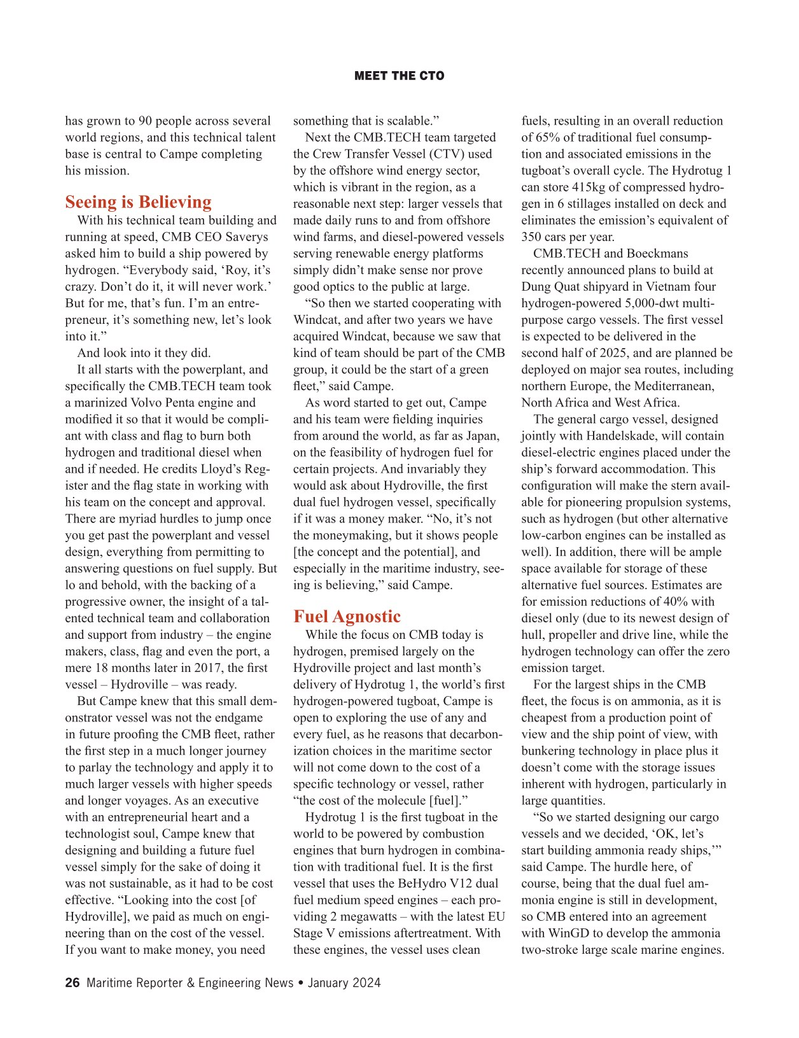
Page 26: of Maritime Reporter Magazine (January 2024)
Read this page in Pdf, Flash or Html5 edition of January 2024 Maritime Reporter Magazine
MEET THE CTO has grown to 90 people across several something that is scalable.” fuels, resulting in an overall reduction world regions, and this technical talent Next the CMB.TECH team targeted of 65% of traditional fuel consump- base is central to Campe completing the Crew Transfer Vessel (CTV) used tion and associated emissions in the his mission. by the offshore wind energy sector, tugboat’s overall cycle. The Hydrotug 1 which is vibrant in the region, as a can store 415kg of compressed hydro-
Seeing is Believing reasonable next step: larger vessels that gen in 6 stillages installed on deck and
With his technical team building and made daily runs to and from offshore eliminates the emission’s equivalent of running at speed, CMB CEO Saverys wind farms, and diesel-powered vessels 350 cars per year.
asked him to build a ship powered by serving renewable energy platforms CMB.TECH and Boeckmans hydrogen. “Everybody said, ‘Roy, it’s simply didn’t make sense nor prove recently announced plans to build at crazy. Don’t do it, it will never work.’ good optics to the public at large. Dung Quat shipyard in Vietnam four
But for me, that’s fun. I’m an entre- “So then we started cooperating with hydrogen-powered 5,000-dwt multi- preneur, it’s something new, let’s look Windcat, and after two years we have purpose cargo vessels. The ? rst vessel into it.” acquired Windcat, because we saw that is expected to be delivered in the
And look into it they did. kind of team should be part of the CMB second half of 2025, and are planned be
It all starts with the powerplant, and group, it could be the start of a green deployed on major sea routes, including speci? cally the CMB.TECH team took ? eet,” said Campe. northern Europe, the Mediterranean, a marinized Volvo Penta engine and As word started to get out, Campe North Africa and West Africa.
modi? ed it so that it would be compli- and his team were ? elding inquiries The general cargo vessel, designed ant with class and ? ag to burn both from around the world, as far as Japan, jointly with Handelskade, will contain hydrogen and traditional diesel when on the feasibility of hydrogen fuel for diesel-electric engines placed under the and if needed. He credits Lloyd’s Reg- certain projects. And invariably they ship’s forward accommodation. This ister and the ? ag state in working with would ask about Hydroville, the ? rst con? guration will make the stern avail- his team on the concept and approval. dual fuel hydrogen vessel, speci? cally able for pioneering propulsion systems,
There are myriad hurdles to jump once if it was a money maker. “No, it’s not such as hydrogen (but other alternative you get past the powerplant and vessel the moneymaking, but it shows people low-carbon engines can be installed as design, everything from permitting to [the concept and the potential], and well). In addition, there will be ample answering questions on fuel supply. But especially in the maritime industry, see- space available for storage of these lo and behold, with the backing of a ing is believing,” said Campe. alternative fuel sources. Estimates are progressive owner, the insight of a tal- for emission reductions of 40% with
Fuel Agnostic ented technical team and collaboration diesel only (due to its newest design of and support from industry – the engine While the focus on CMB today is hull, propeller and drive line, while the makers, class, ? ag and even the port, a hydrogen, premised largely on the hydrogen technology can offer the zero mere 18 months later in 2017, the ? rst Hydroville project and last month’s emission target.
vessel – Hydroville – was ready. delivery of Hydrotug 1, the world’s ? rst For the largest ships in the CMB
But Campe knew that this small dem- hydrogen-powered tugboat, Campe is ? eet, the focus is on ammonia, as it is onstrator vessel was not the endgame open to exploring the use of any and cheapest from a production point of in future proo? ng the CMB ? eet, rather every fuel, as he reasons that decarbon- view and the ship point of view, with the ? rst step in a much longer journey ization choices in the maritime sector bunkering technology in place plus it to parlay the technology and apply it to will not come down to the cost of a doesn’t come with the storage issues much larger vessels with higher speeds speci? c technology or vessel, rather inherent with hydrogen, particularly in and longer voyages. As an executive “the cost of the molecule [fuel].” large quantities.
with an entrepreneurial heart and a Hydrotug 1 is the ? rst tugboat in the “So we started designing our cargo technologist soul, Campe knew that world to be powered by combustion vessels and we decided, ‘OK, let’s designing and building a future fuel engines that burn hydrogen in combina- start building ammonia ready ships,’” vessel simply for the sake of doing it tion with traditional fuel. It is the ? rst said Campe. The hurdle here, of was not sustainable, as it had to be cost vessel that uses the BeHydro V12 dual course, being that the dual fuel am- effective. “Looking into the cost [of fuel medium speed engines – each pro- monia engine is still in development,
Hydroville], we paid as much on engi- viding 2 megawatts – with the latest EU so CMB entered into an agreement neering than on the cost of the vessel. Stage V emissions aftertreatment. With with WinGD to develop the ammonia
If you want to make money, you need these engines, the vessel uses clean two-stroke large scale marine engines. 26 Maritime Reporter & Engineering News • January 2024
MR #1 (18-33).indd 26 1/8/2024 11:21:59 AM

 25
25

 27
27
